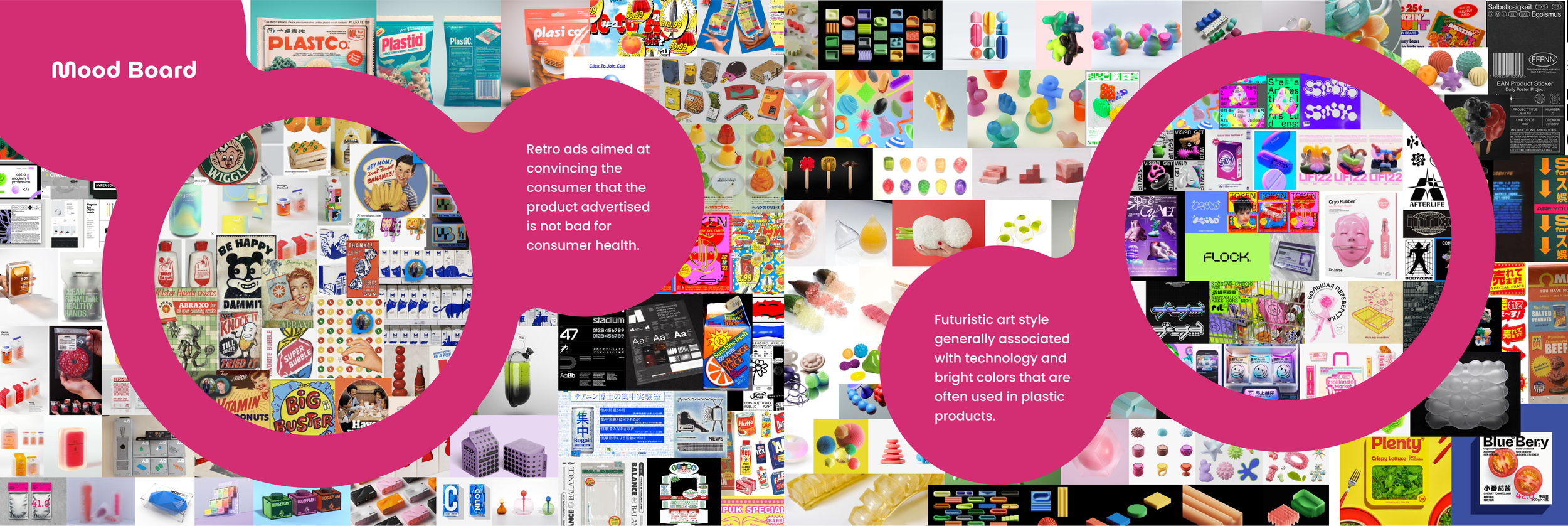Plix / 2023
Overview
This satirical speculative design project explores the normalization of plastic consumption as a sustainable food source, using greenwashing, propaganda, and data manipulation to promote its benefits. Through branding, interaction, and service design, we examined how these tactics could shape public perception and influence consumer behavior.
The project investigates how deceptive marketing tactics like greenwashing, manipulated data, and propaganda influence public perception and normalize microplastic consumption as a sustainable food source. It focuses on analyzing consumer behavior, developing branding strategies, and designing interactive and service elements to promote microplastic-based food as a cheaper and sustainable alternative.
Project Objectives
I researched the plastic recycling industry and the impact of microplastics, focusing on how recycled plastics are processed and their environmental and health effects. I also took the lead in developing the branding and marketing strategy, creating a family-friendly, futuristic brand identity and a marketing plan to effectively reach a broad audience. I used Blender to create 3D models of the food products, giving them a gummy, plastic appearance with vibrant colors and unique textures.
My Role
Brand Book






















Touchpoints
Plix incorporates small, medium, and large touchpoints, from packaging that provides product details to a fully developed website offering comprehensive information on Plix’s health and safety benefits, and a simple purchasing process.
I designed and modeled all the food in Blender, focusing on creating textures that look unnatural and plastic, while still being appetizing and visually appealing to consumers.
The Plix Bar serves as an alternative to traditional nutrition bars, offering more protein at a lower cost. It's designed to be highly portable and convenient, making it ideal for people with busy schedules or childcare duties. The bar is marketed as a practical option to keep on hand, easily fitting into a bag for when you need a quick nutritional boost.
Food
Plix Pieces have the sweetest flavor profile, while still being filling due to their plastic content. They are marketed towards a younger audience, with bright colors, unique shapes, and sweet flavors making them appeal to kids.
The Plix Power Box is a ready-to-eat meal designed as an alternative to frozen foods or microwave meals. It can be eaten straight from the box or heated up. Targeted mainly at adults seeking a full meal rather than just a protein bar, it is promoted as a quick dinner option for busy days.
Website
The Plix website, created in Figma, provides important information about the safety of Plix products. Customers interested in changing their diet may have questions about the nutritional value of plastic and how it works. The website serves as a resource for answering questions, building trust in Plix Foods, and facilitating purchases.
The Home and About pages are specifically designed to address any concerns or alarms potential customers may have about incorporating microplastics into their diet. The e-commerce section of the website aims to expand on the information found on Plix Foods packaging and offer customers an easy way to purchase products.
Taskflow
Marketing
One portion of our advertising focuses on normalizing microplastic-enhanced food by explaining how the plastics are collected, sanitized, and processed. Our ad campaigns also highlight the environmental benefits of consuming microplastics. The goal is to demonstrate how eating microplastics is safe and can contribute to saving the planet.
Plix uses product posters to clearly describe the taste of each food item to potential customers. These posters highlight the health benefits of Plix foods and encourage purchases. The intention is to normalize the consumption of microplastics by showing everyday people interacting with Plix products.
Plix’s digital marketing employs bright colors and highlights the texture and flavor of Plix food products. Social media also serves as an entry point for many users interested in purchasing Plix products, directing them to the website.
Digital Marketing
Visual Identity
Plix’s branding is approachable and trustworthy, blending vibrant colors with a clean, modern design. This creates a friendly image that consumers can rely on for a sustainable snack, positioning Plix as a dependable choice for both quality and sustainability.
The Plix logo and brand mark, set in MuseoModerno Bold, is typically displayed in bright pink but can also be rendered in white for dark backgrounds to enhance visibility. We chose to highlight the "x" in the logo as the brand mark because its distinctive shape reflects the playful, energetic character of the brand.
Logo
MuseoModerno is used for bold titles that catch the eye, while Poppins is used for body text to ensure clarity and readability. This combination makes titles stand out and keeps the text easy to read, providing a balanced and effective design.
Typography
The bright color palette reflects the unnatural hues of Plix food products, making them visually striking yet appetizing, and reinforcing the brand’s playful, futuristic vibe. For the primary palette, we kept the iconic Plix Pink to boost brand recognition, pairing it with light greys and deep maroon for contrast.
Colors
Research
By selectively presenting information and quotes, we crafted a narrative that supports the consumption of plastics under the guise of technological and environmental progress. We used the tobacco industry as a case study for marketing carcinogenic products.
Traditional plastic recycling methods like incineration are costly and produce harmful byproducts, but modern techniques such as pyrolysis, gasification, and hydrocracking are being used to convert plastic waste into fuel. Bioremediation involves using microorganisms to break down plastic, with some beetle species capable of this process under specific conditions. Using recycled plastic in food products could be a way to repurpose plastic waste sustainably, with no evidence regarding the negative effects of micro- and nano plastics on human health in the long term.
Recycling Plastic
Tobacco companies use a variety of tactics to promote their products, such as sponsoring influencers and events to boost brand visibility and create a fun, positive image. Eye-catching packaging with bold colors and logos helps attract and retain customers. Historically, ads have downplayed health risks, with funded research designed to cast doubt on smoking's dangers. Targeted marketing has focused on specific groups, like young adults, through products such as flavored cigarettes. Ads span print, radio, TV, and online platforms, often featuring glamorous imagery and celebrity endorsements. Innovations like 'light' or 'low-tar' cigarettes, aimed at health-conscious consumers.
Case Study
Personas
We created three user personas with various backgrounds to better understand Plix customers by highlighting the diverse needs, challenges, and motivations of different target groups.
24D5H2 is an overworked parent balancing a hectic job and family life, struggling to provide convenient and nutritious meals for her three children.
62F900 is a construction worker with no kitchen or time to cook, seeking quick, nutrient-rich meals to fuel his physically demanding job.
447FS0 is an unemployed individual with limited mobility and resources, needing easy-to-prepare, affordable food options that require minimal effort.














